Welcome to the 2020 edition of Quill & Pad’s early Grand Prix d’Horlogerie de Genève predictions in which the team picks favorites and explains why.
The panelists are:
Elizabeth Doerr (ED), co-founder and editor-in-chief
Ian Skellern (IS), co-founder and technical director
Joshua Munchow (JM), resident nerd writer
GaryG (GG), resident collector
Martin Green (MG), resident gentleman
The Diver’s category contains watches linked to the field of diving, whose functions, materials, and design are suited to this activity.
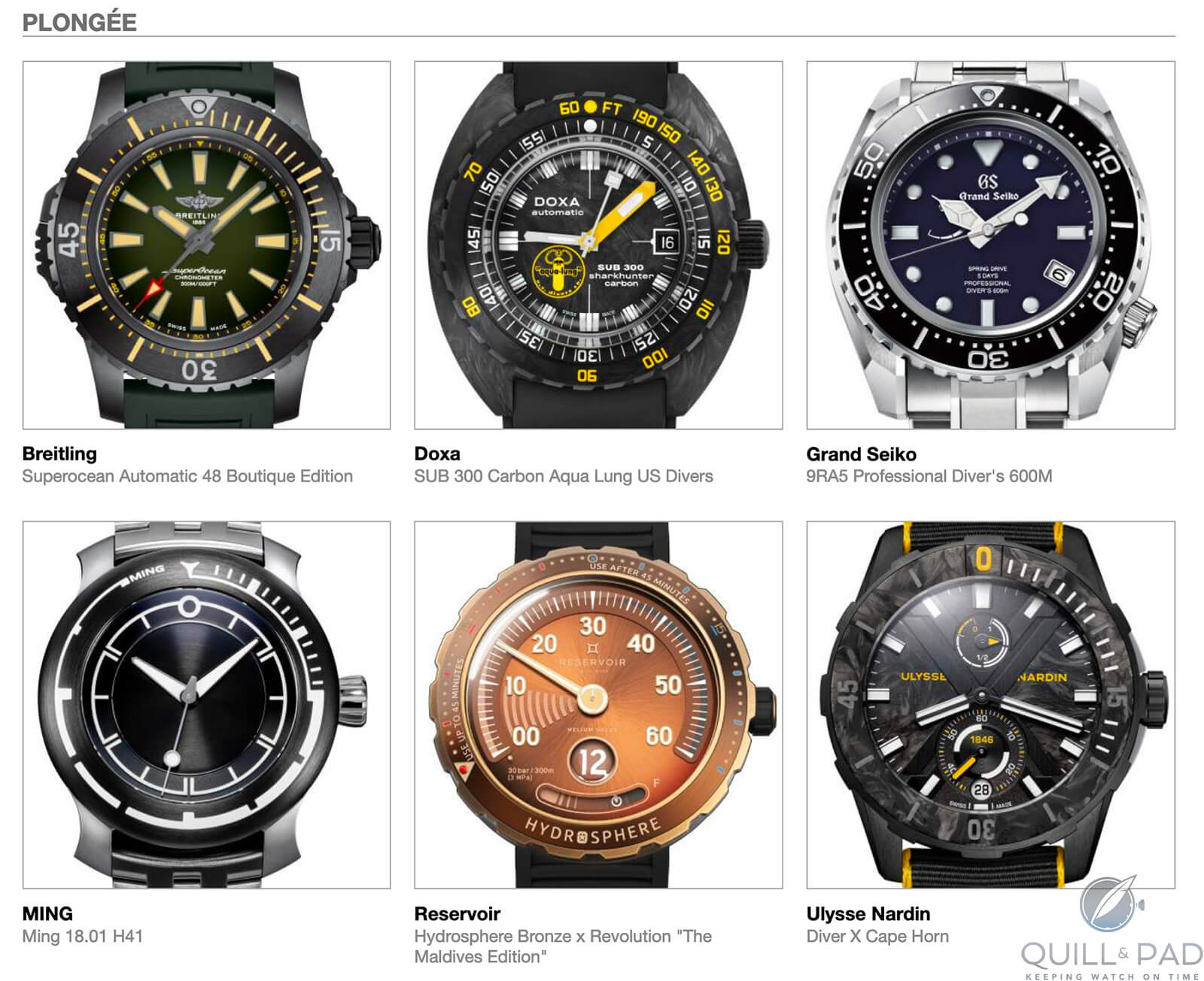
The nominated Diver’s watches of the 2020 GPHG: Breitling Superocean Automatic 48 Boutique Edition, Doxa SUB 300 Carbon Aqua Lung US Divers, Grand Seiko 9RA5 Professional Diver’s 600M, Ming 18.01 H41, Reservoir Hydrosphere Bronze x Revolution The Maldives Edition, Ulysse Nardin Diver X Cape Horn
MG: Judging the Diver’s category is always the easiest as the first thing you have to do is to separate the desk divers from the real divers. That usually leaves you with just two or three as the rest often look great but could be liabilities underwater due to a confusing layout or poor legibility. A diving watch should be straightforward; hence the most successful ones also look very much alike.
GG: If there’s one category of timepieces that I know less about than I do these underwater pieces that have been rendered superfluous by the perfection of dive computers, it’s the Jewellery category. And we’ll get to that soon enough!
I’m tempted to call a six-way dead heat among this group and move on, but given that the good people at each of these brands worked very hard to create these pieces, I’ve done my best to do some decent study of them – without getting too deep into things like the diver’s watch standard ISO 6425, which I’ll leave to the true enthusiasts.
To make things a little easier on myself, I’ll first split the six watches into three tiers, with the Ming and Grand Seiko on top, the Breitling and Doxa in the middle, and the Reservoir and Ulysse Nardin bringing up the rear.
IS: I thought the Diver’s category was going to be easy on my first scan through the nominated watches. I quickly noted a clear winner and was thinking of how to write a few encouraging words for another watch that I thought was way outclassed here. Turned out after that studying the form, my outclassed entry ended up outclassing everyone else. Sorry for the mix of sports metaphors, but this was a slam-dunk, hole-in-one, homerun choice for me here despite the extremely strong field.
ED: For me, the real diving instruments here are the Doxa, the Grand Seiko, the Breitling, and the Ming – though the Ming is almost more like a design piece than a real instrument. However, like Ian, the more I considered it, the more appealing it became. But I’ll get to that.
JM: The Diver’s category is always an easy category for me because the purpose of a diver’s watch is a possibly life-saving instrument, so the best diving watch will be the easiest to read, the easiest to use, and most capable with high build quality and approachable price. This year we have some great pieces, but in my opinion one stands head and shoulders above the rest, even with its one design flaw. I predict right now that our own jury will likely be unanimous in our predictions, giving you a little bonus prediction today.
IS: The rules state that these watches should feature functions, materials, and design, that are suited to diving. So let’s see how they shape up for that role.
Breitling Superocean Automatic 48 Boutique Edition
MG: That you don’t have to tell Breitling how to make a diving watch is evident from this Superocean. With a diameter of 48 mm this watch is huge and, therefore, easy to read and operate. Everything is generously coated with Super-LumiNova, which you appreciate when you dive deeper. A case in titanium and ceramic means you don’t have to account for a heavy watch when determining how much weight to carry. The water resistance is more than sufficient at 300 meters, as even most experienced recreational scuba divers rarely go below 50 meters.
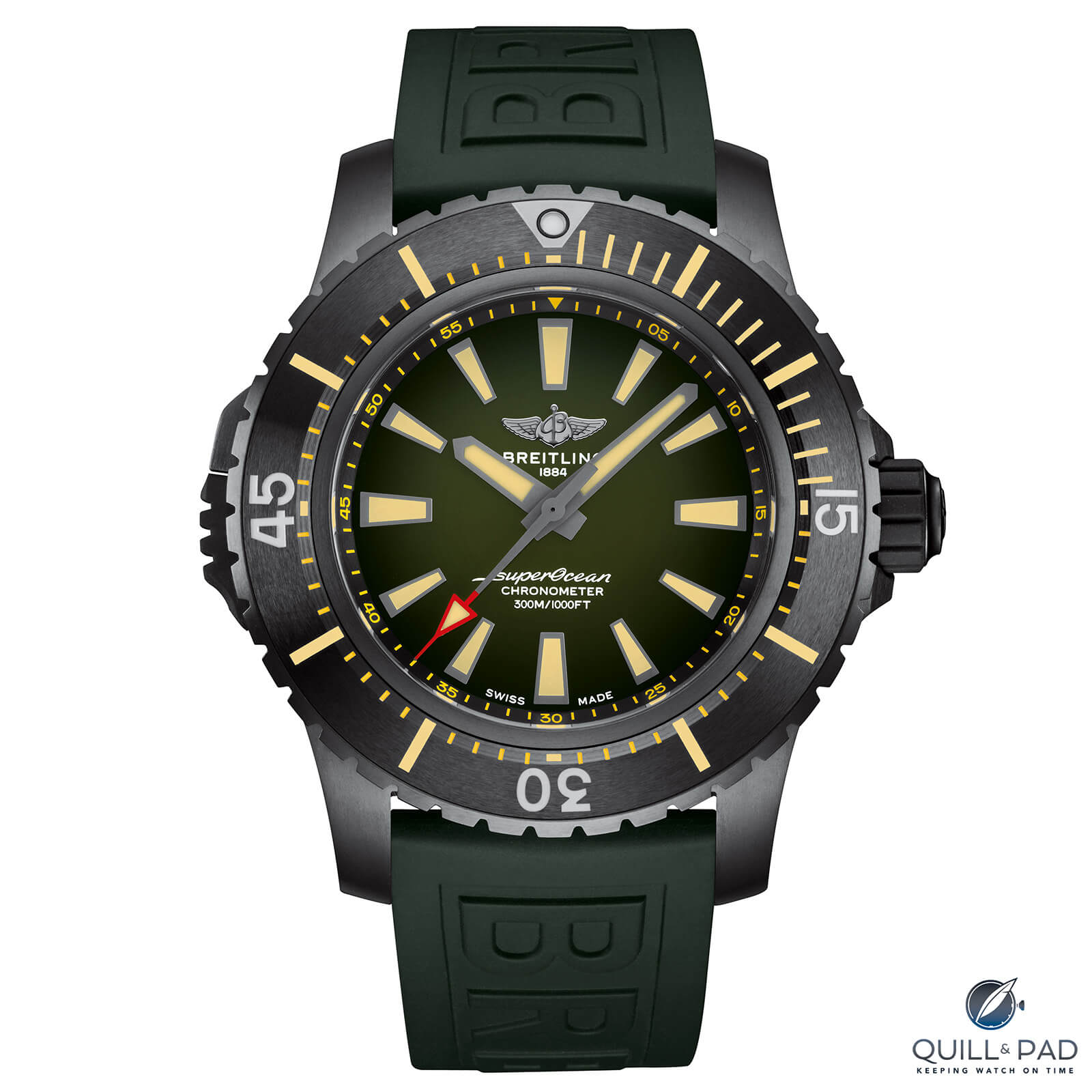
Breitling Superocean Automatic 48 Boutique Edition
MG: My only negative comment would be that a power reserve of just 38 hours is no longer up to modern-day standards. As a dive definitely won’t last any longer than that, and the watch features automatic winding, it won’t make a difference. But it would be nice if Breitling were to join the rest of us in 2020 and offer at least 48 hours.
JM: The Breitling Superocean is a very rugged, military-style diving watch with large features, a clean dial and bezel, and a bonus internal iron case to protect against magnetic fields. Made from titanium and ceramic, it is sure to hold up to abuse and thanks to large markers it should be relatively easy to read underwater.
One downside is the lume color isn’t the brightest of all the lume color options, which hurts underwater legibility a bit, but that is offset a bit by the marker size. It’s relatively large, which may hurt its chances to win (people still wear these watches mostly NOT diving) but it’s a great, affordable diving option. I have it as my second runner up for its very solid and functional design as a diving watch.

Breitling Superocean Automatic 48 Boutique Edition
ED: While the Superocean usually is my favorite Breitling line, this instrument watch is decidedly not part of the “Heritage” part of the line that I find so attractive. This is an instrument, and it shows in the massive size and decided tool styling. Breitling itself describes this watch as, “big, bold, and bulky.” Yep. While, as the others have noted, it is likely a perfect watch for real diving, desk divers may find the styling too rugged.
IS: The Breitling Superocean Automatic 48 Boutique Edition is an epitome of the traditional serious diver’s watch. It’s big (48 mm diameter), beefy (17 mm thick), and with a locking bezel, iron Faraday cage protecting the balance from magnetitic fields, and 300-meter water resistance, this Superocean Automatic 48 is a serious tool watch. The generous lume is may glow brightly in the dark, but its daytime contrast is lower than if a lighter color. But that’s a relatively minor gripe, the big problem here is the Grand Seiko, which beats the Breitling on every measure for traditional tool dive watches (at the cost of being double the price).
Quick Facts Breitling Superocean Automatic 48 Boutique Edition
Case: 48 x 17.25 mm, black DLC-coated titanium with ceramic bezel, soft iron inner case for magnetic fields; 300 m water resistance
Movement: automatic Caliber 17 (base ETA 2824-2), power reserve 38 hours, 4 Hz/28,800 vph frequency
Functions: hours, minutes, seconds
Price: CHF 5,350 / €5,250
Doxa SUB 300 Carbon Aqua Lung US Divers
IS: Doxa is synonymous with dive watches, so it’s no surprise that the SUB 300 Carbon Aqua Lung US Divers ticks all of the boxes, including, I’m pleased to note, an official C.O.S.C. chronometer certificate. The carbon case is a lighter-weight bonus and I like the bright yellow on black color scheme. But for a serious diver’s watch I find the dial to be too busy, and while I know it’s not a race to the bottom of the ocean, 300-meter water resistance isn’t enough to make the top tier against the competition here.
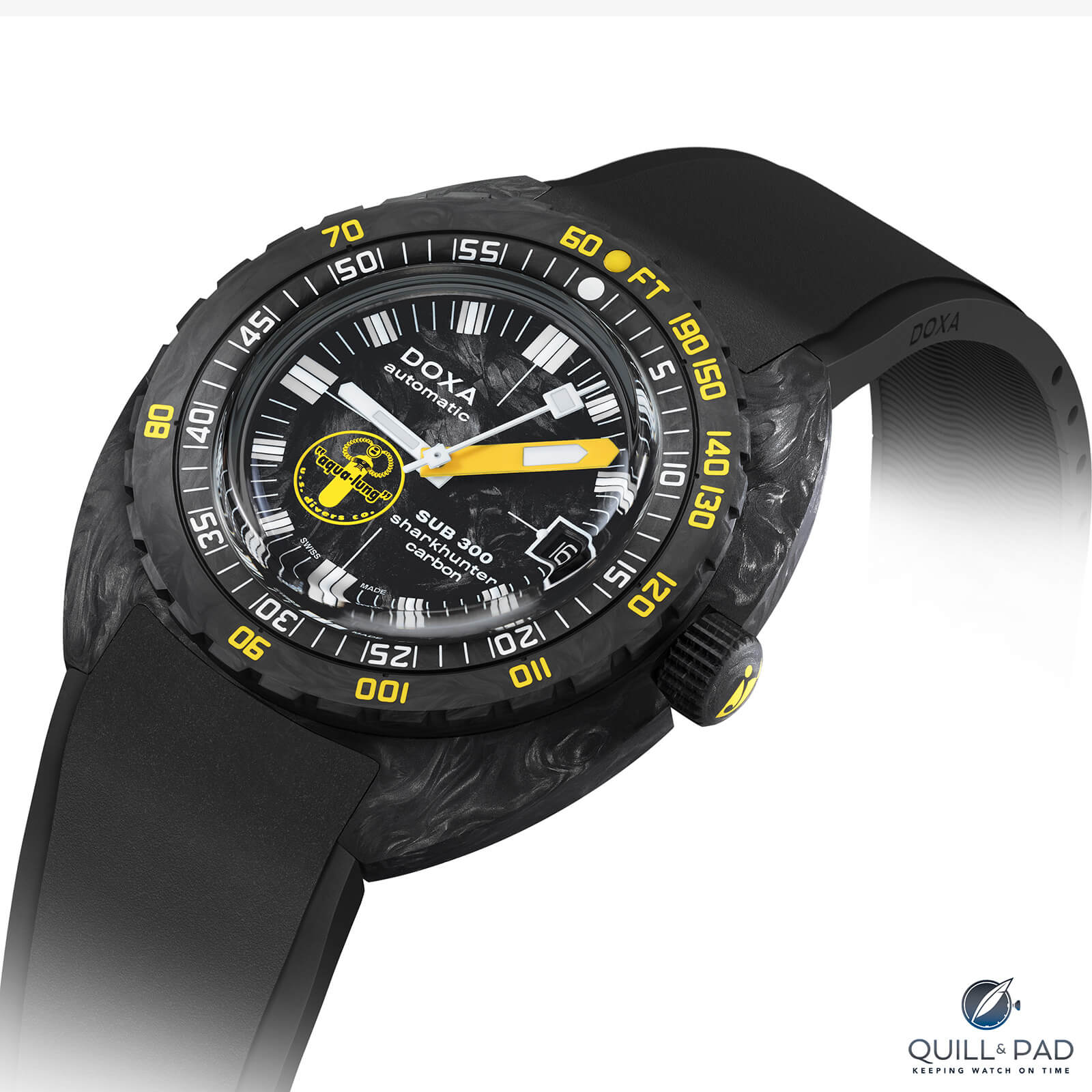
Doxa SUB 300 Carbon Aqua Lung US Divers
MG: You don’t have to tell Doxa how to make a diver’s watch, either . . . or do you? The SUB 300 provides too much information and has too much distracting text and logo on the dial. What I especially don’t get is why Doxa hardly filled in those bold hands with Super-LumiNova. That’s a rookie mistake as it makes it much harder to read the elapsed time in low-light conditions, which is the norm when you dive.
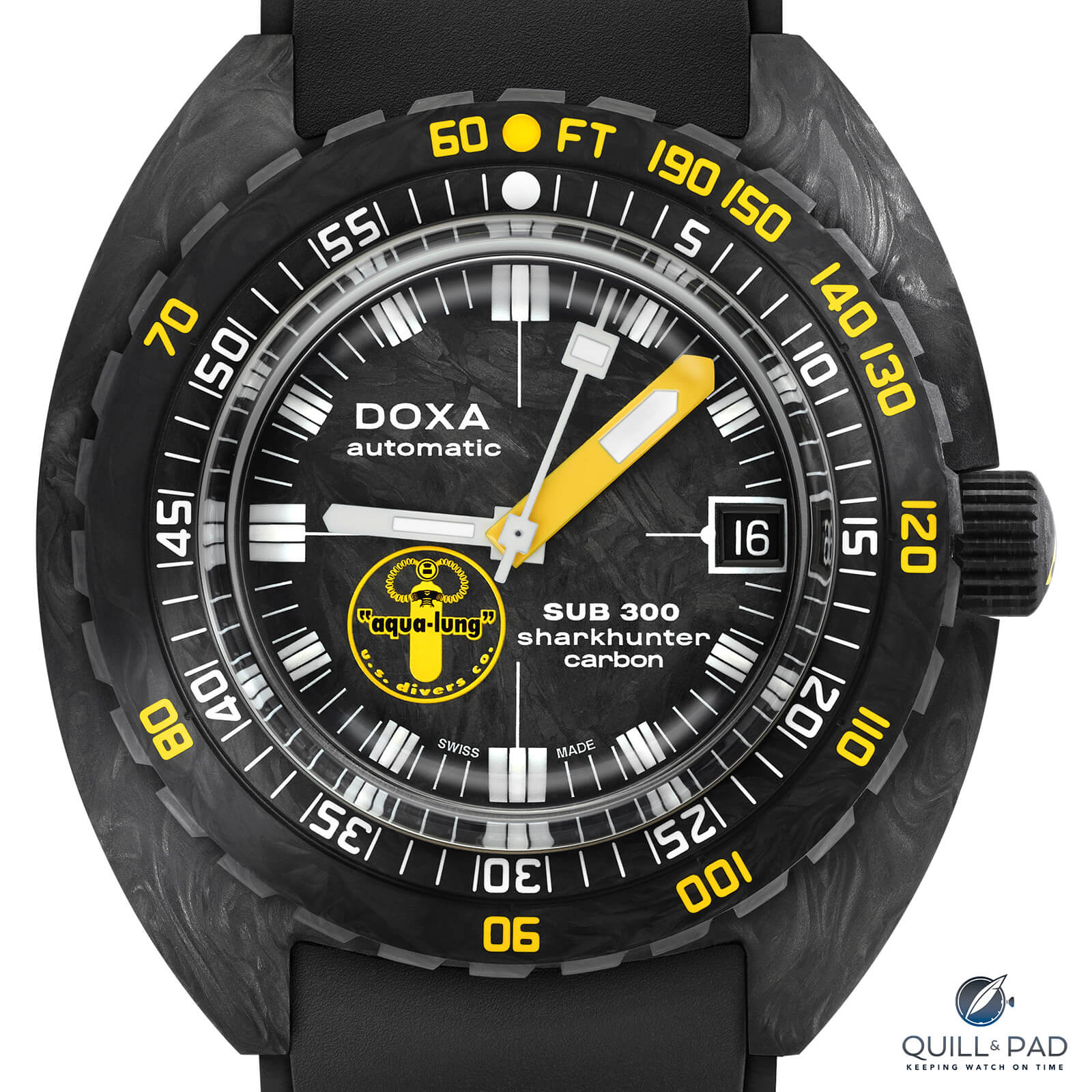
Breitling Superocean Automatic 48 Boutique Edition
MG: That is even more surprising when you consider that this watch is a limited edition in collaboration with Aqua Lung, the brand of dive equipment founded by Jacques Cousteau and Emile Gagnon. That being said, the carbon case is very cool and the watch is well proportioned despite its relatively small dial, but to me it is more a desk diver than something I want as a backup for my diving computer.
JM: Doxa is historically known to make fantastic diving watches, having built its brand around being one of the premier diving watches with a relationship with famous diver Jacques Cousteau. The SUB 300 was even the watch made famous by Cousteau and has a great history with Aqua Lung edition pieces. So one would expect the new SUB 300 Aqua Lung edition to be tough competition, but I don’t honestly think it matches up in legibility or functionality. The dial on this is smaller than the others, it is busier and less visually clean than the others, and it seems more intent on sticking with historical aesthetics and layouts than improving the capability of the watch to be read underwater. Perhaps I am wrong, but other pieces here are easier to read so better diving instruments.
Quick Facts Doxa SUB 300 Carbon Aqua Lung US Divers
Case: 42.5 x 13.4 mm, forged carbon, titanium inner chamber for pressure resistance; screw-down crown; 300 m water resistance
Movement: automatic Caliber ETA 2824, power reserve 38 hours, 4 Hz/28,800 vph frequency; official C.O.S.C. chronometer certification
Functions: hours, minutes, seconds
Limitation: 300 pieces
Price: CHF 5,350 / €4,790 / $4,790
Grand Seiko 9RA5 Professional Diver’s 600M
IS: At my first glance of the six finalists together, I thought that the Grand Seiko 9RA5 Professional Diver’s 600M would likely be my hands-down winner because it looks like and is the perfect traditional tool dive watch. The only watch giving it a run for its money is the Breitling. But the Seiko is slimmer with double the water resistance (600 m versus 300 m).
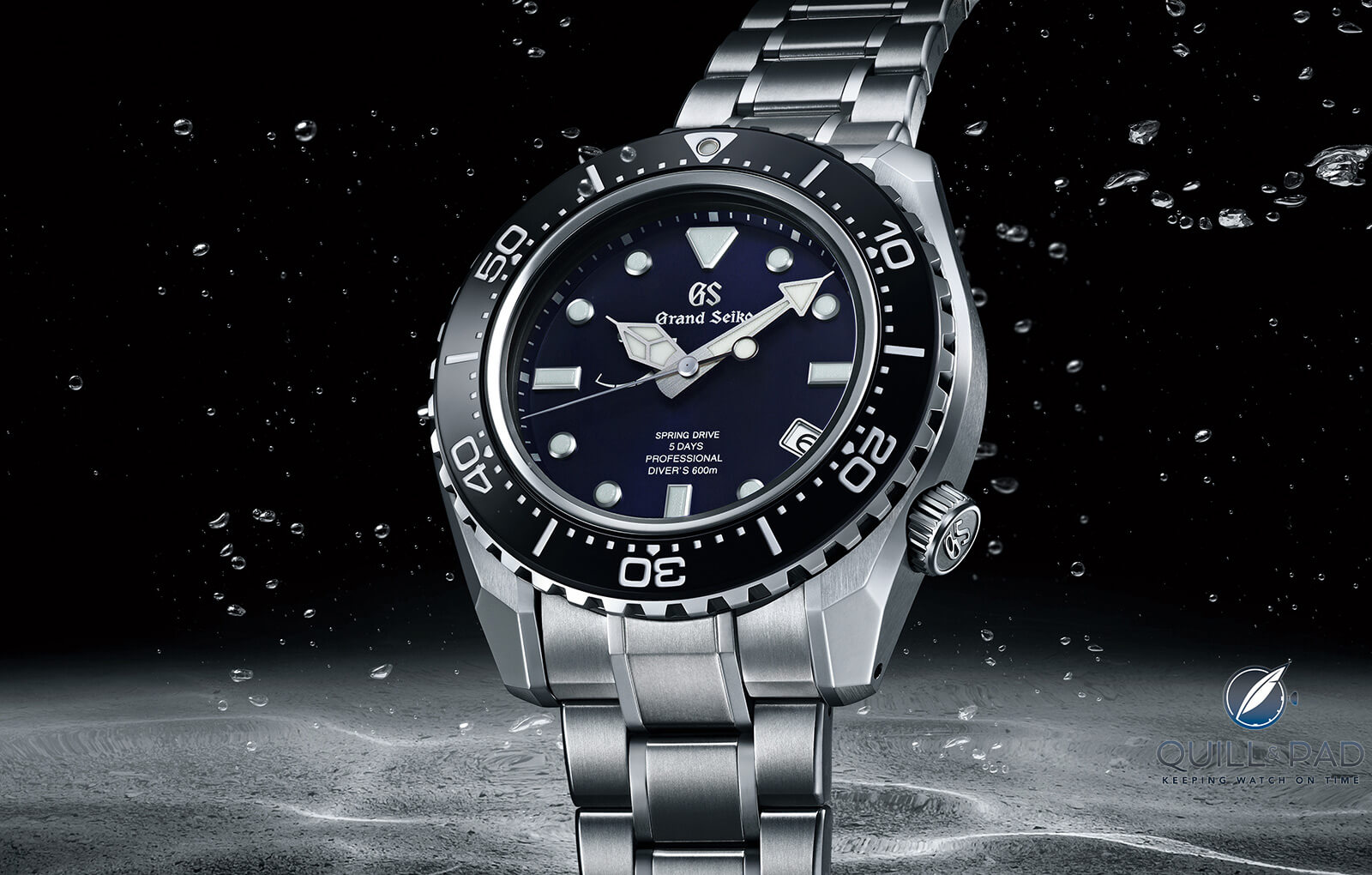
Grand Seiko 9RA5 Professional Diver’s 600M
IS: And the 9RA5 Professional Diver’s 600M looks exactly how you would dream a professional diver’s watch to look, no extra details visible but essential information for the diver. The legibility is superb. I’ll point out the mismatched date wheel as a visual flaw, but aside from that the Grand Seiko 9RA5 Professional Diver’s 600M is just perfect for what it is. It’s my runner up in this category.
ED: This rugged Grand Seiko has twice the depth rating as all of the competitors (save one) and easily twice the power reserve of the rest. Its lovely zaratsu-polished high-intensity titanium case exhibits more beauty than the rest of its competitors (save one), and its bracelet features a sliding extension, which is perfect for fitting over a wetsuit. I’d say that this watch is a decent choice for a desk diver as well. I am also a big fan of the Spring Drive movement.
But this Grand Seiko is also two and three times the price of its competitors in this category (with the exception of the Ulysse Nardin, which is less but close). For that reason and also others as we’ll see in the next segment it is my runner up.
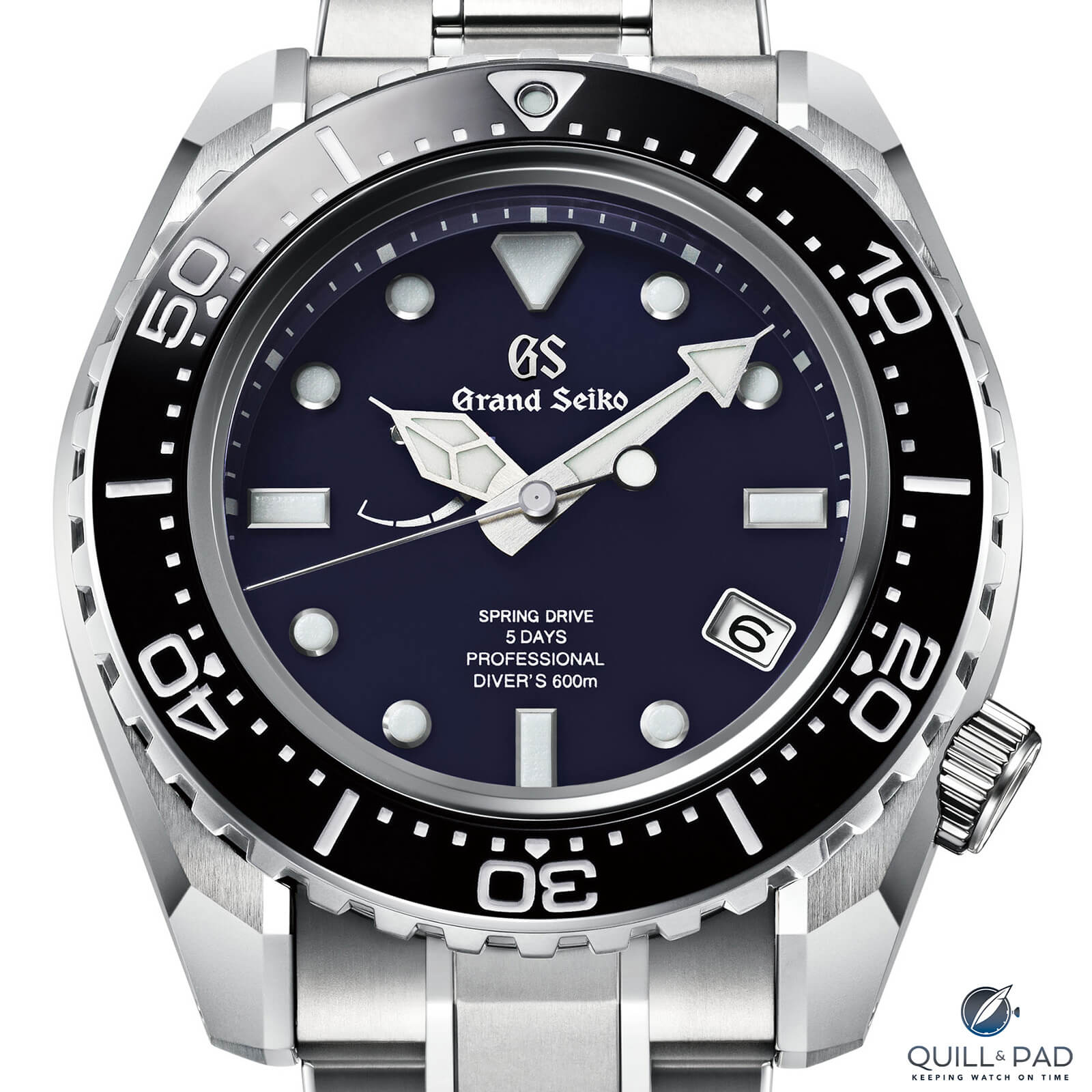
Grand Seiko 9RA5 Professional Diver’s 600M
GG: The Grand Seiko, at least in photos, has the sheen and pop of a top-quality watch, including using the brand’s proprietary case polishing techniques that create those sharp, crisp edges. It’s very large indeed at almost 47 mm in diameter and a whopping 16 mm in thickness, though, and I’m not a total convert when it comes to the Spring Drive movement. It’s tough to keep this one out of the top spot, though, especially given its classic looks.
JM: Grand Seiko isn’t usually one of the first brands you think of when naming off diving watches – though Seiko is – and since Grand Seiko is part of Seiko there was always a professional diver watch from the marque.
The 9RA5 Professional Diver’s 600M is a very solid diving watch with the second highest depth rating in the competition, a clean, legible dial and traditional bezel, and features a Spring Drive movement with five days’ worth of power reserve. If it wasn’t for my top pick in the category, this would win in my book. As such, it is outdone by a scrappy newcomer and is my first runner up and an awesome option for a very capable diving watch.
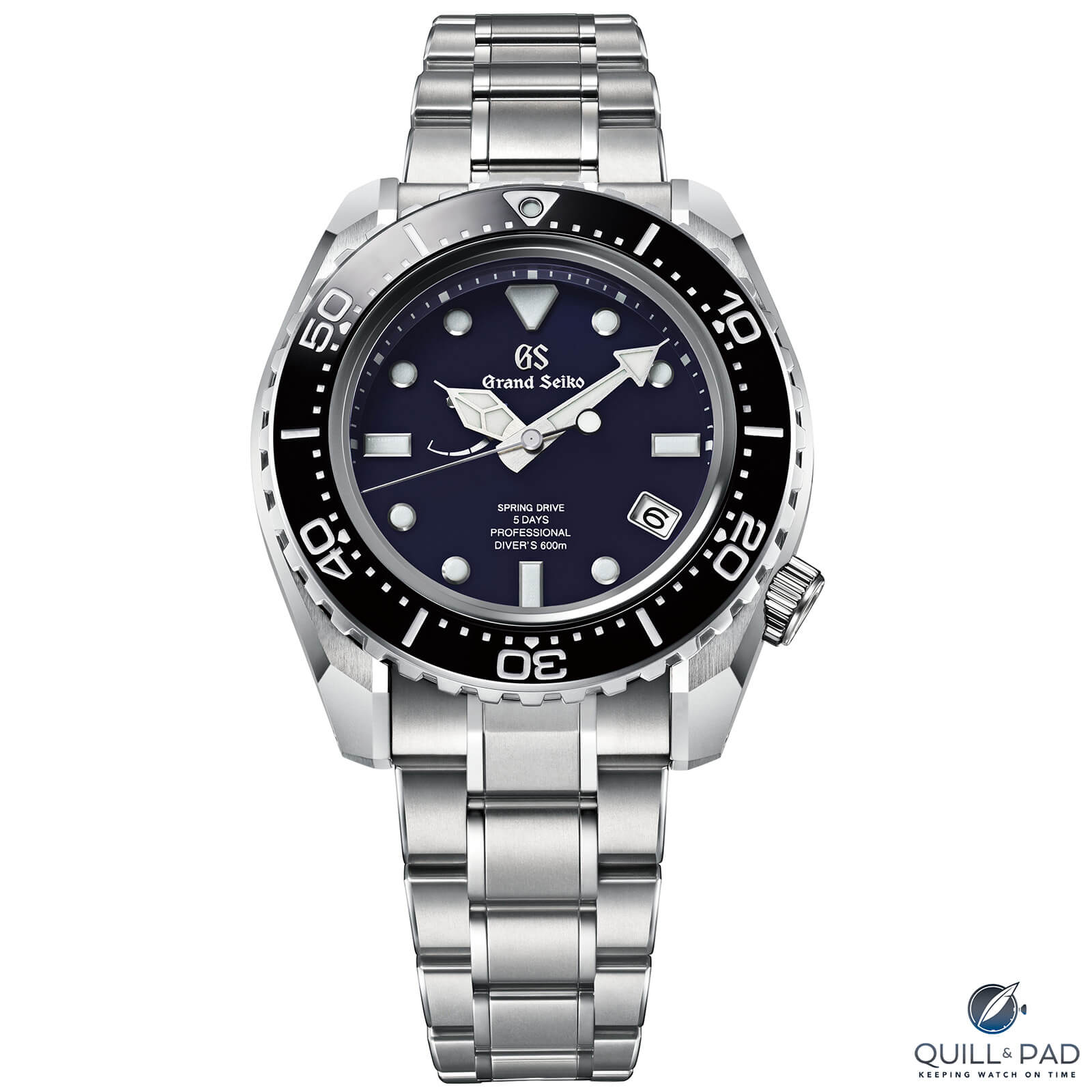
Grand Seiko 9RA5 Professional Diver’s 600M
MG: The winner is, at least for me, the Grand Seiko. The only downside of this watch is that the brand still hasn’t given it a good and impressive name. Not to worry, though, as its fans will give it a nickname soon enough.
This watch ticks all the boxes and looks as good in the water as outside it. Even more, you can take it diving with peace of mind. All the information a diver needs can be read at a glance, it comes with a reliable Spring Drive movement, and as a bonus has a bracelet in which the Grand Seiko engineers invested as much time as they did with the rest of the watch. This watch is the full package, at least underwater. As a desk diver, I find this Grand Seiko less appealing, as it is too large for my wrist (but not my wetsuit) despite it being made of titanium.
Quick Facts Grand Seiko 9RA5 Professional Diver’s 600M
Case: 46.9 x 16 mm, titanium; 600 m water resistance
Movement: Seiko Spring Drive Caliber 9RA5, power reserve 120 hours
Functions: hours, minutes, seconds; date, power reserve indication
Limitation: 700 pieces
Price: CHF 12,400
Ming 18.01 H41
JM: I’ll say it right off the bat: this one feels like the winner, hands down. And I think everyone else here except Martin is going to agree with me. First, it has a 1000-meter (not feet, but meters) water-resistance rating with a stated 20-percent safety margin. It does away with excess markings but has plenty of lume across the very clean dial and bezel. The unique bezel design provides an intuitive scale that just makes sense as a delineation of elapsed time, not to mention the progressively diminishing scale to indicate depleted oxygen reserves.
Like all the best diving watches it is made in titanium with an awesome titanium bracelet (and includes a rubber strap as well), and it is the most affordable watch in the bunch by a decent margin.

Ming 18.01 H41 dive watch
JM: Its one design flaw is the lack of a fluted bezel, and while this is a serious absence it is well outpaced by the other positives. This watch demonstrates the founding principles of the Ming brand more than most of its watches as it is a supremely collectible watch that is affordable and seems to be the result of watch lovers who know what makes a great watch. Ming is a pretty awesome brand and I think they knocked it out of the park with this watch. It would be hard to say another is a better diving watch than this one this year.
IS: I read all the details of the Ming 18.01 H41 when it was released and had the opportunity to handle one myself during Geneva Watch Days, and I like it. Very much. And I thought it very well speced and competitively priced. It was comfortable on the wrist, looked good, and I thought that it was an excellent contemporary reinterpretation of the traditional dive watch.
But it was only when I saw the Ming 18.01 in the group of six contenders for best dive watch 2020 that I realized I had an hitherto unknown preconception: I thought it an excellent contemporary reinterpretation of the traditional dive watch, but then I thought it would have been more accurate to add a few more words to the end to read: “. . . an excellent contemporary reinterpretation of the traditional dive watch. But it isn’t really a serious dive watch (it’s too good looking and wearable). And there are no numerals on the dial, which proved my point. Game, set, and match to Grand Seiko. Job done.”
When I saw the group photo of the six nominated dive watches, I thought that the Ming 18.01 H41 stood out for its clean, contemporary design, but was simply outgunned among so many serious tool dive watches.
At only (in this group) 40 mm in diameter and 13 mm in height, the Ming 18.01 is sized more like a daily wearer than a deep diver. But is does both roles superlatively: titanium case, 1,000-meter (that’s one kilometer!) water resistance, crown screw-out warning indicator, high-visibility lume, and costing 3,250 Swiss francs? That’s a slam dunk 2020 GPHG Best Diver’s watch for me.
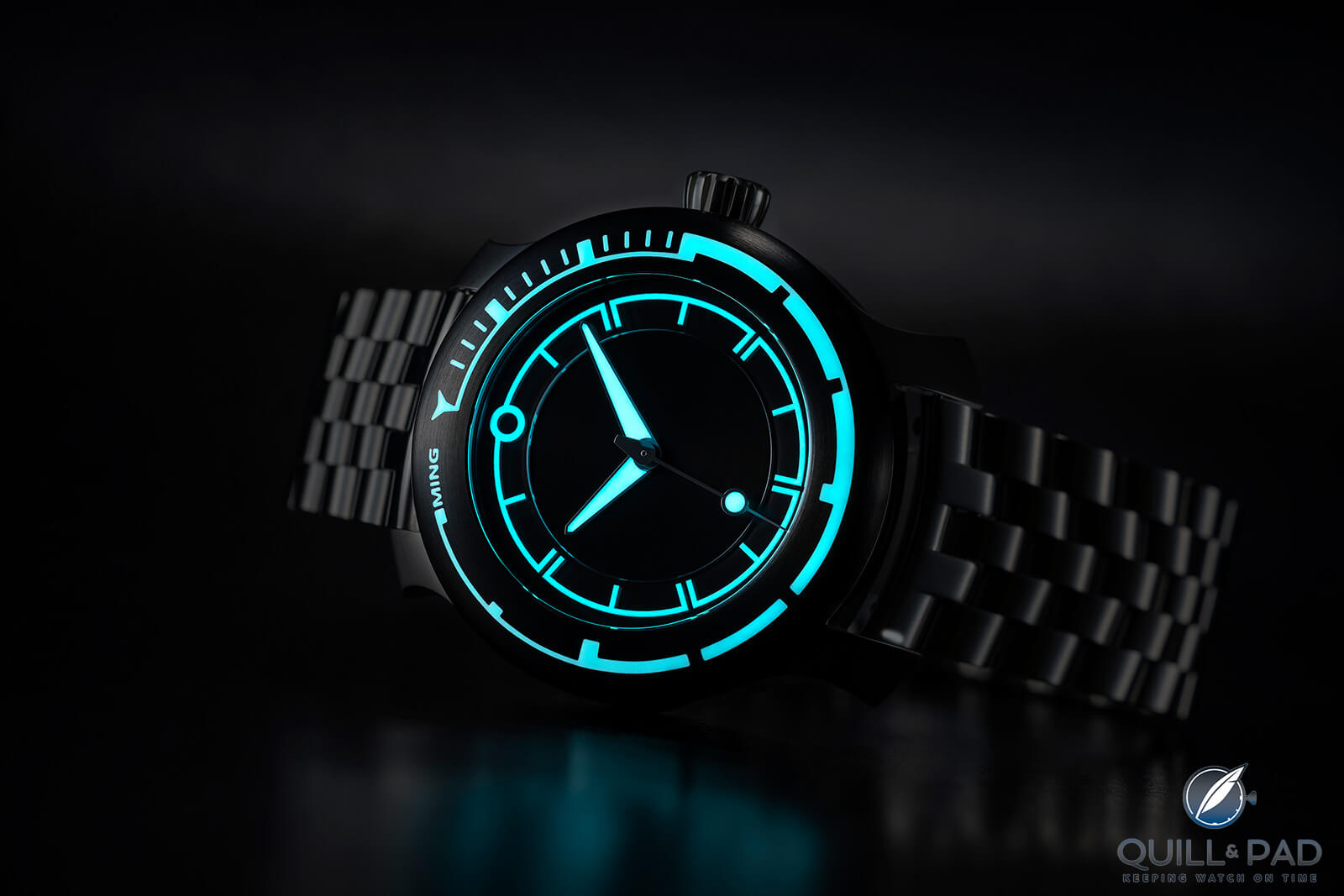
Ming 18.01 H41 dive watch: serious lume in the dark
GG: Just because I can, I think I’ll go with the Ming 18.01 H41 as my winner in this category. Ming has managed a whopping 1,000 m water resistance in a cool, minimalistic, and not immense (40 x 12.9 mm) package. And a variety of typically practical features such as the red warning indicator for an unscrewed crown and a grippy case back surface to hug your neoprene sleeve should you ever decide to wear it for anything other than desk diving is included.
I’ll confess that the absence of numerals on the bezel probably makes this a slightly less-than-ideal diving partner, but the way that the markings change in each 15-minute segment of the dial helps. And when it’s time for your three- or five-minute safety stop you can easily crank the bezel around to bring the y-shaped bezel marker to the current time. So for me, it’s the Ming in this category with the Grand Seiko just a hair back.
ED: Ming has advanced to a full-blown brand, leaving behind the adolescent status it had enjoyed up to this year in pursuit of real adult watches with a full-blown collection. And of course a diver must be present in such a collection. And what a diver! Even though it has practically every attribute you need to reliably dive – including an amazing 1,000 meters of depth – it still remains a very wearable and attractive timepiece for every day.
My only misgiving is the absence of numerals, which makes it slightly less suited to becoming a true diving instrument like the Breitling or the Grand Seiko. But what I do like about it is that it can be easily worn outside the water space and not look like a fish out of water.
Nonetheless, like Ian, Ming has taken me by surprise with this watch and I too must call it my winner.
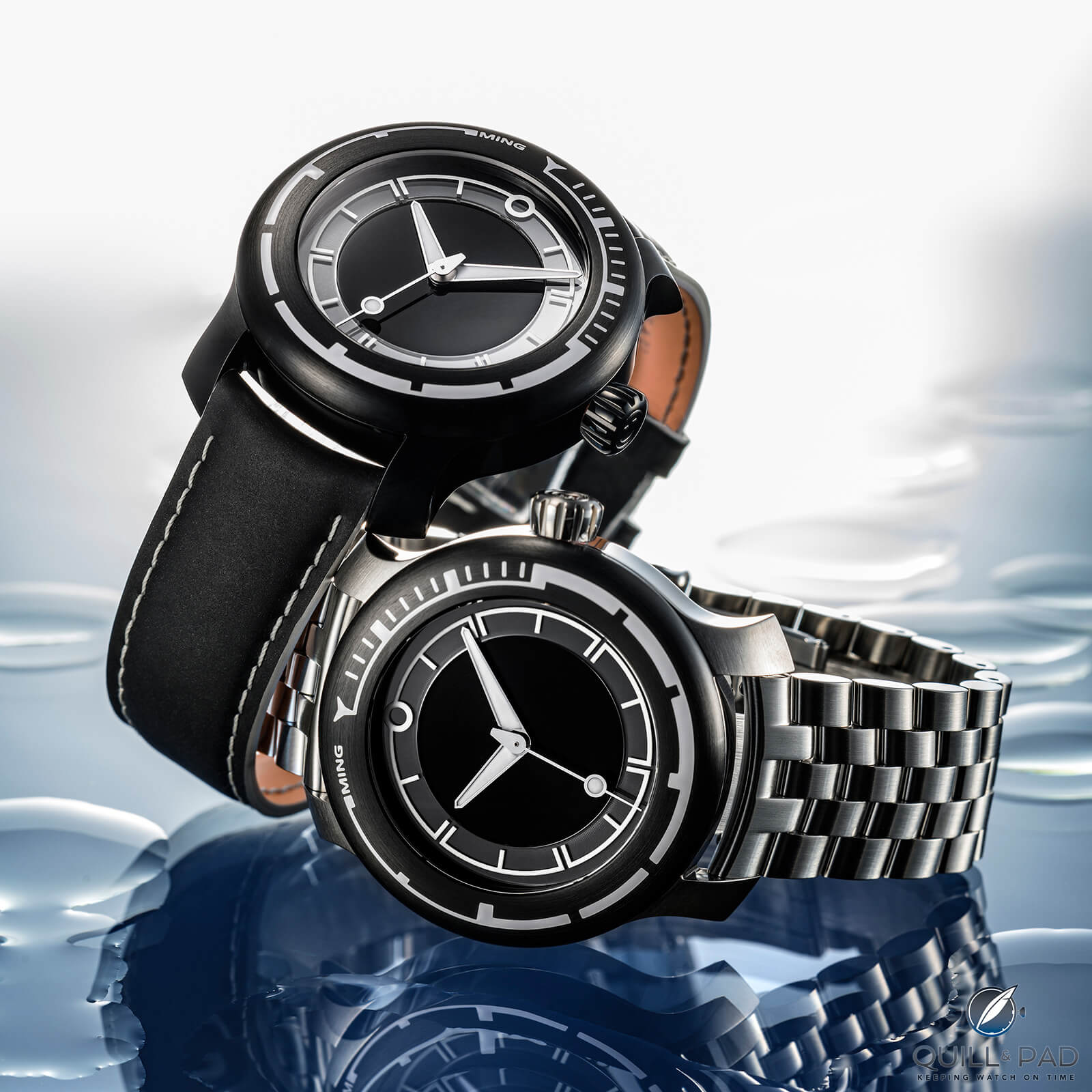
Ming 18.01 H41: a serious dive watch for work and play
MG: I think that Ming has proven in a very short period of time that it is capable of making very good and stunning-looking watches, but the 18.01 is not among those for me. Yes, the build quality is really good, but I find its design way too eccentric for a diver’s watch.
Underwater it simply takes too long to determine how much time has passed since the beginning of your dive, which can be potentially dangerous. As a desk diver, it feels far more at home, and there it turns its design from a disadvantage into an advantage as it is most certainly different from all the other (and there are many) diving watches out there.
Further reading: Ming 18.01 H41 And 27.01: Revolution And Evolution
Quick Facts Ming 18.01 H41
Case: 40 x 12.9 mm, titanium with DLC-coated stainless steel bezel, 1000 m water resistance
Movement: automatic Caliber ETA 2824-2 (modified), 40-hour power reserve, 28,800 vph/4 Hz frequency
Functions: hours, minutes, seconds
Price: 3,250 Swiss francs
Reservoir Hydrosphere Bronze x Revolution The Maldives Edition
MG: This is another great-looking watch that I would love to take for a swim, but never for a dive. It is simply too complicated to determine the diving time that has already passed. I know that it is very tempting to try to re-invent the diving watch, but it is so hard (and perhaps even impossible) to surpass the design standards set by the pioneers in this field such as the Rolex Submariner and Blancpain Fifty Fathoms. However, as a desk diver, I think that the Reservoir is a very strong and appealing design, although to take full advantage of that I would have loved to see it 3 mm smaller.
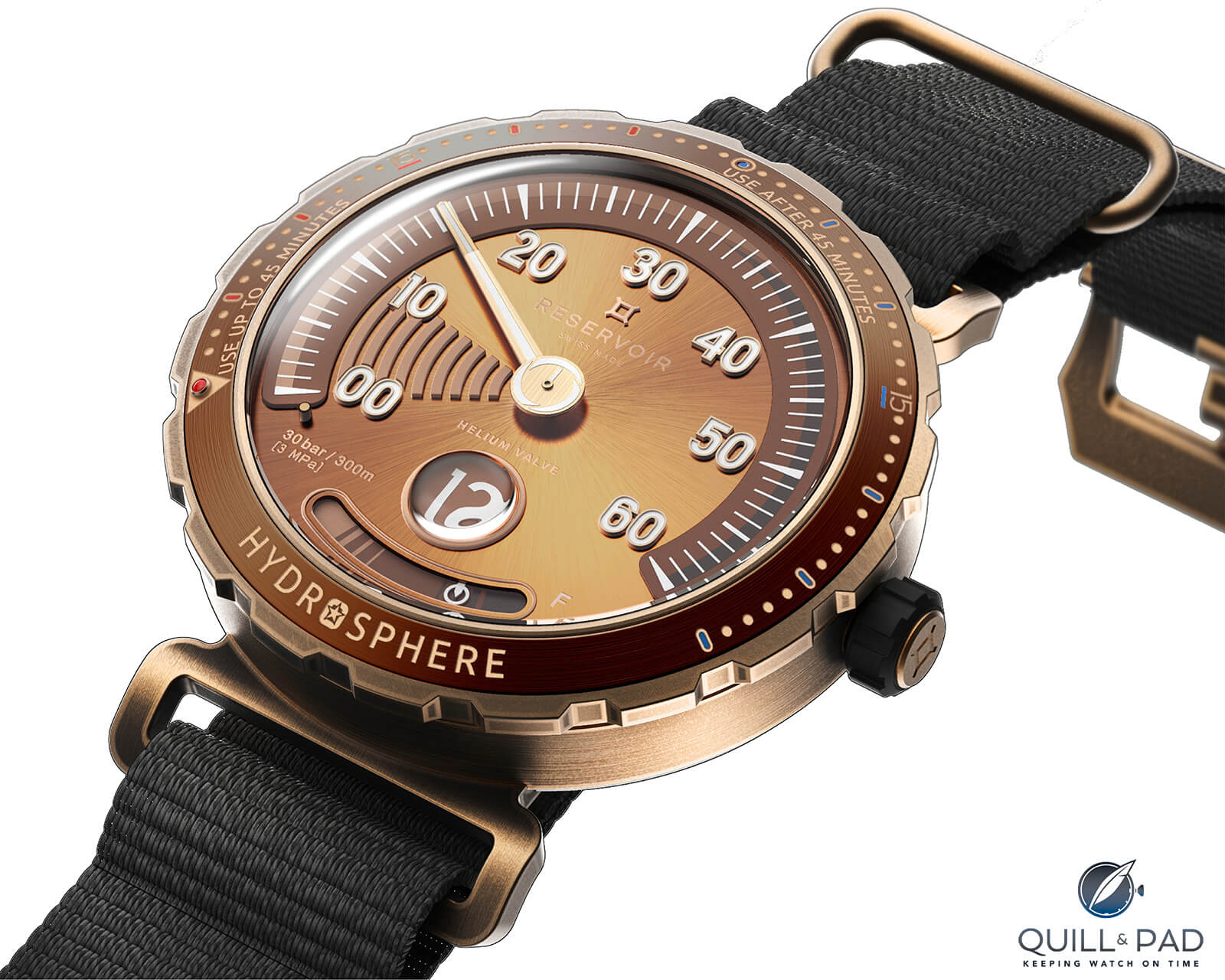
Reservoir Hydrosphere Bronze x Revolution The Maldives Edition
IS: First thing I noted while reading the details for this Reservoir Hydrosphere on the GPHG website is that the English looks to have been translated from largely content-free French using an old version of Google translate. It speaks to the strength of this watch to get nominated with that information handicap.
Retrograde minutes on a dive watch may work okay, but they significantly reduce the length of the minute scale compared to using the full 360 degrees of the dial. And that is a busy dial, it has too much going on for me there for a dive watch. As a dry-land watch I like it – the hours and minutes look very legible – but it’s swimming in the big pool here against, literally and metaphorically, much bigger fish.
JM: Reservoir is a brand that I like aesthetically. I completely dig the jump hour and retrograde functions. It also would seem like it makes a natural ally with the diving watch aesthetic, but, according to the standard diving watch functions, the Hydrosphere Bronze x Revolution falls short. The atypical bezel combined with the retrograde minute hand makes a functionally poor indicator for elapsed time some of the time, meaning that it can’t be trusted all of the time.
When a hand is not be guaranteed to continue in a line of travel every time you will be read it, it has the occasional possibility of being confusing to track elapsed time. If your life didn’t depend on it then no big deal, but that is not the case with a diving watch. Regardless of how cool the watch is, I don’t think it makes a good diving watch and don’t think it will take this category.

Reservoir Hydrosphere Bronze x Revolution The Maldives Edition
GG: I do like the Reservoir watches and the brand’s ability to create a variety of different themes and embodiments for its signature retrograde minutes and jump hour complication, but sadly the retrograde minutes approach renders the reading of elapsed underwater time on the bezel just about impossible for me, with one tiny scale to be read when fewer than 45 minutes have elapsed and a second for times over 45 minutes. I know that these watches won’t actually be used underwater, but I can imagine having nightmares in which I’m peering intently at this watch while diving as my air tank empties.
ED: I am fully on the same page as you, Gary: this watch makes little sense to me as a real diver’s timepiece. It is very attractive, and I also like the combination of unusual displays, but I would hope this piece is never actually relied upon as an underwater instrument – even though with a 250-meter ability to dive it would be able to. Take it for a swim instead, people.
Further reading: Reservoir Watch Supercharged Classic: (Relatively) Affordable Swiss Quality
Quick Facts Reservoir Hydrosphere Bronze x Revolution The Maldives Edition
Case: 45 x 14.9 mm, bronze with ceramic bezel and helium valve, 250 m water resistance
Movement: automatic Caliber ETA 2824-2, 37-hour power reserve, 28,800 vph/4 Hz frequency
Functions: jumping hours, retrograde minutes; power reserve indication,
Limitation: 100 pieces
Price: 4,350 Swiss francs
Ulysse Nardin Diver X Cape Horn
MG: Ulysse Nardin has changed course to a more daring design route, and I think that it’s paying off. Daring but also enticing, the Diver X is a perfect example of this. The brand utilized the carbon texture perfectly throughout the bezel and dial and gave the entire watch a very sleek design. I am not a fan of the canvas strap, but that is something that is quite easily remedied. The manufacture movement ticks all the boxes and comes with plenty of silicon parts, a technology that Ulysse Nardin spearheaded.
While I am not a fan of putting an X in every watch, I am also not particularly bothered by it and think that all combined, Ulysse Nardin put together a capable watch, particularly when it comes to tempting a new generation of watch enthusiasts. For me, it needs to settle for third place as I think it is a capable diving watch, yet I prefer mine with minute hashmarks and a central second hand as it is easier to see at once that your movement is still running.
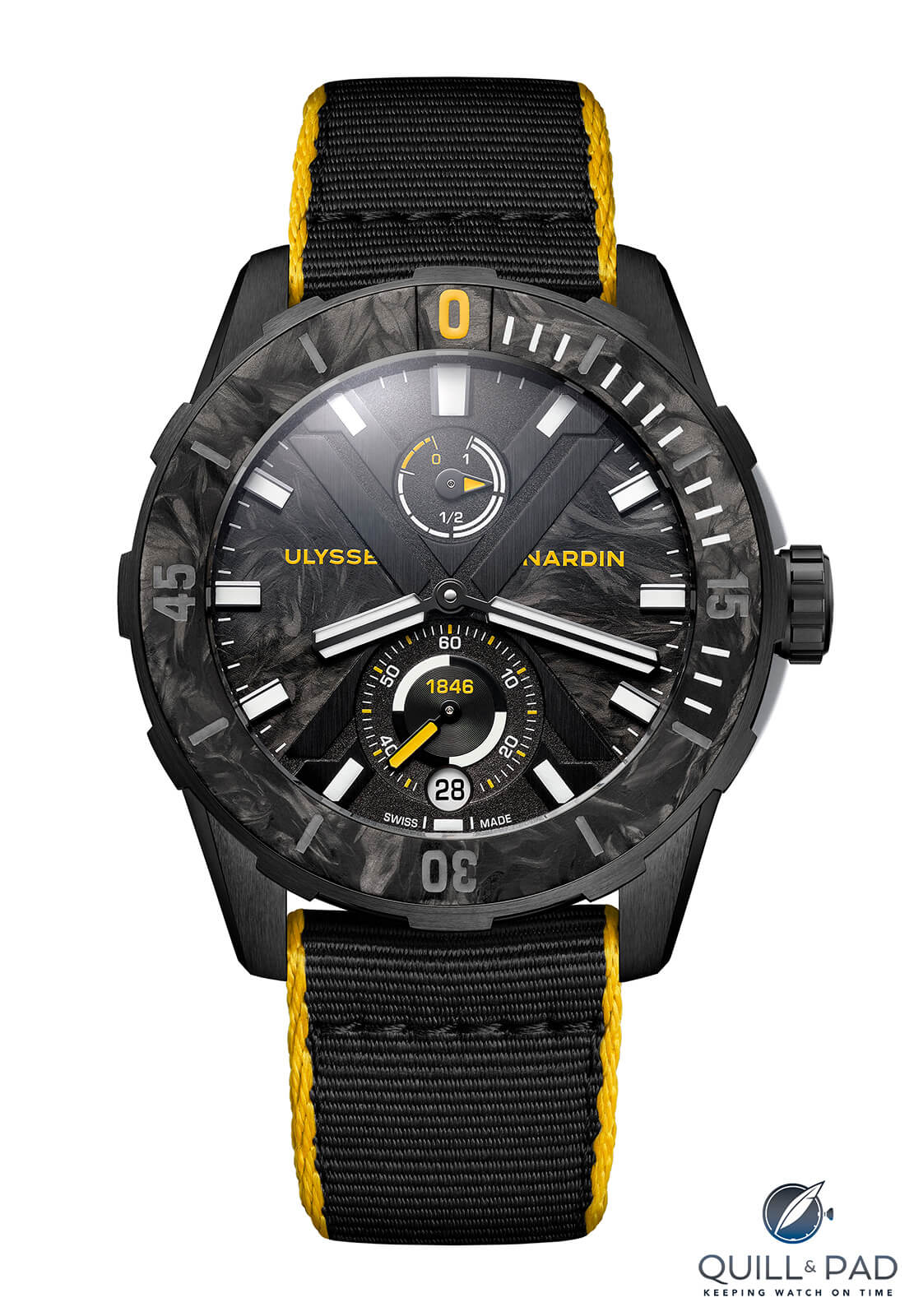
Ulysse Nardin Diver X Cape Horn
IS: Ulysse Nardin has a long history in nautical and dive watches, and this brand knows how to do them well. The 44 mm titanium and carbon fiber case should be comfortable to wear even above water and the power reserve indicator is a good touch – useful information to know before you head down into the depths. And the non-magnetic silicon escapement is another plus for divers. The Ulysse Nardin Diver X Cape Horn is a strong middle fielder but doesn’t make my top two in this lineup.
GG: The Ulysse Nardin looks like a durable and dramatic piece, but even the brand itself doesn’t position it as a diving watch – it’s for yacht racing. I’m guessing that the conditions sailing around Cape Horn are going to be a lot tougher than anything I’d experience reef-floating at 30 feet down off of Molokai, so no offense to UN on this one.
JM: This is a watch that I can easily set aside from consideration because while it is a diver in technical terms, it was designed for an open ocean sailing race and was not optimized for diving specifically. It will work, and it’s a superbly capable watch, but with the underwhelming bezel and superfluous design elements that don’t necessarily aid in its function as a diving watch, it just doesn’t live up to others in the category.
This is the only category where I will use the end-use case as the driving criteria since lives depend on it functioning properly. This watch just is not the best iteration of a dive watch out of this group.
Quick Facts Ulysse Nardin Diver X Cape Horn
Case: 44 x 14.86 mm, titanium and carbon fiber, 300 m water resistance
Movement: automatic Caliber UN-118 with silicon escapement, 60-hour power reserve, 28,800 vph/4 Hz frequency
Functions: hours, minutes, seconds; date, power reserve indication
Price: 9,900 Swiss francs
Predicted Winners
Elizabeth: Ming 18.01 H41
Ian: Ming 18.01 H41
Joshua: Ming 18.01 H41
Gary: Ming 18.01 H41
Martin: Grand Seiko 9RA5 Professional Diver’s 600M
For more information on all of these watches, please visit www.gphg.org/horlogerie/en/gphg-2020/nominated-watches#2020_PLONGEE.
You may also enjoy:
Leave a Reply
Want to join the discussion?Feel free to contribute!





















































Seriously, how a limited production pieces can seriously be competing in the dive/tool watch category? It’s part of the quest to establish a solid production AND servicing abilities. So even though Seiko is limited run, it is not unique watch and can be bought or serviced. But Ming! I understand press can push something, but a watch that is impossible to get and is not produced serially isn’t a tool. A one off land rover defender prototype with custom parts and three people in solihull who can fix it CANNOT compete in farmer’s workhorse category.
Hi Eugene, It’s worth noting that there is nothing in the category rules about these watches being “tool watches”or for professional divers. The rules simply state: “. . . watches linked to the field of diving, whose functions, materials, and design are suited to this activity.”
Regards, Ian
Touché. Well spotted.
But,
In the watch enthusiast world in 2020, we can award a trophy to a divers watch, a tool designed by engineers in the 1950s, and rendered obsolete by the end of the 90s, 20+y ago. So obviously, the practical considerations of servicing are a mere distraction in this well made PR event.
At least specialized media talk about some watches in a different way than usual (some, like here do, not all).
If one considers the frame of rules to comply to, to be called a divers watch, rules merely changed in the past 65y, You understand why most offering of diver’s watches look the same. In that context, 2 out of six here depart from the “Sub” holy design. Ming and reservoir. Who ever has seen a bronze watch after2-3y of aging, especially if it has met seawater and sun, cannot award Reservoir. But elections are a world of surprises.
Ming design is fresh and will logically win. They get my vote (well, virtual support) .
The watch is limited and was all gone within minutes of the start of its online sale, proving that the attraction has much to do with the looks and emotion the product carries and very little to do with awarding the best (obsolete) tool.
Today the best divers watch is used mostly for desk diving. In that category, ming should get the award for best novelty.